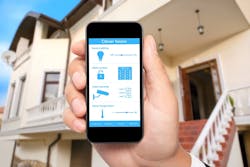Security companies have played a pivotal role in the proliferation of smart home technology from the very beginning, however, these same firms will find themselves challenged in the coming years as several industry developments stand poised to disrupt the market’s status quo, according to a new research note from IHS Technology.
“Moreover, security companies will be challenged in 2017, when UL-compliant Z-wave sensors hit the market. (UL has approved the latest Z-Wave protocol for UL 1023 compliance, which means Z-Wave detectors can soon be used for professional alarm installations.) This milestone is significant, because most existing intruder alarms use one-way radios operating at 300/400 megahertz (MHz),” wrote Blake Kozak, principal analyst at IHS Technology, in the research note. “In order to remain competitive in 2016 and 2017, dealers and service providers need to consider flexible billing models as well as DIY installation with professional monitoring.”
In addition, Kozak said that the smart home market will continue its evolution toward machine-to-machine (M2M) communication ecosystems, which will subsequently increase the number of devices consumers interact with on daily basis inside their homes and thus provide more opportunities for companies to upsell additional products and services. And though the fragmentation of the smart home market may mean that products such as smart televisions, set-top boxes, routers and audio-based home devices (e.g. Amazon Echo and Sonos) will soon be jockeying for position with traditional hubs and panels, security companies still find themselves in relatively strong position, according to Kozak.
“Despite this fragmentation, security companies have not been displaced,” added Kozak. “Many are now offering self-contained panels offering open functionality, as well as peripheral devices that can be managed locally via voice control or as part of a larger ecosystem.”
Other highlights from the research note include:
- In 2015, there were approximately 16 million smart security devices -- both do-it-yourself (DIY) and professional -- shipped in the American market.
- There were 8.5 million professionally installed smart security devices shipped in 2015
- Beyond security, 15.5 million smart appliances, thermostats, light bulbs and plugs shipped in 2015
- Among the 410 companies actively providing smart home services, devices and platforms IHS analyzed, 228 supported more than one protocol
- Wi-Fi was the most popular protocol, representing 34 percent of the protocols supported by all 410 companies; Z-Wave followed with 18 percent


